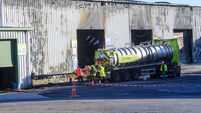Where Rome fell, New York endures
They wanted, as all humans do, to understand how and why such a devastating event could have happened.
Some have argued that 9/11 marked a new era in history, while others, such as Richard Haass, who writes today as part of the Irish Examiner’s coverage of the tenth anniversary, have argued that it was just an event. But we are a species looks for patterns, so we looked to history for parallels.
One parallel that cropped up again and again on certain discussion groups, particularly religious ones, was one between New York and the fall of Rome in the fifth century. It was felt that New York of the 21st century was akin to the imperial capital of 1,600 years previous.
There was some merit to this. New York had become for many, and certainly for the hijackers, the symbol of the West. For some, it represented culture and ambitious spirit, for others it was a den of iniquity. By striking at a symbol of global capitalism at the heart of one of the best-known cities of the Western world, it showed that the very system at the heart of Western society was vulnerable.
As a tactical move, it showed to everyone that terror could come to their doorstep — that is certainly the message people across the US took in the immediate aftermath.
The parallels between the effect of 9/11 on our culture and the sacking of Rome in 410AD are interesting, because they illustrate how one city can be held up as a symbol of its time. As a historian, I do not believe that to be a fair comparison, even if it is understandable.
Rome was the greatest city of its time and place, even if it had been in decline for some centuries. We tend to have a static picture of what Rome was, which is bloody, glorious, refined and rich. It was all these things, but it was no longer a paradigm, even if it was continuously held up as one.
When Alaric the Visigoth attacked the city, he came as a former officer in the Roman army who sought a kingdom for himself. While his army did devastate the city, overall the Germanic tribes of this time wanted to enjoy the benefits of the empire, not destroy it.
Economically, it hastened the decline of western Europe. For religious, cultural and political reasons, it was the end of an era.
This is where the analogies between Rome and New York break down. The US city must be viewed in its own economic, cultural and political context.
American power has not collapsed, although its moral authority has been devastated because of the enormous cost in lives and economics of its wars in Afghanistan and Iraq. Indeed, America is probably stronger now than it was then, although the Bush administration’s lies — particularly regarding links between al-Qaida and Saddam Hussein — and the constant stream of military deaths and casualties has caused deep division. Nonetheless, almost all Americans would agree that 9/11 was still an attack designed to terrorise the nation.
Economically, the city suffered, although it has recovered somewhat. And while Alaric’s march on Rome achieved glory for himself, while also hastening the decline of an empire, New York has rebuilt. As the article published in yesterday’s Irish Examiner showed, the city is rising from the dust clouds of the World Trade Center attacks and is becoming more vibrant and diverse than before.
Whether we regard 9/11 as opening a new era of history or not, the fact remains that we should look to history only for parallels and lessons rather than as a map. New York does, and should, stand in its own stead. We should not foist historical models or thought onto the city, but leave it to make its own mark on history.













